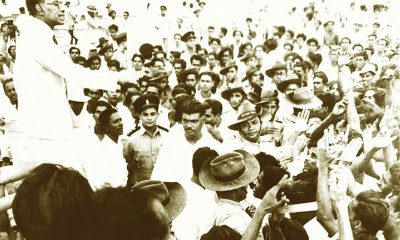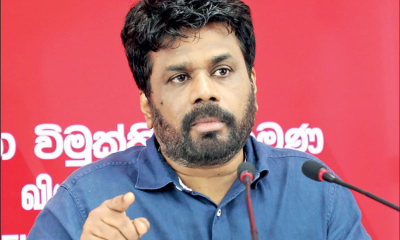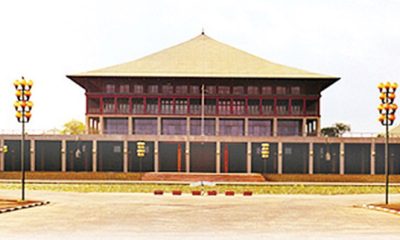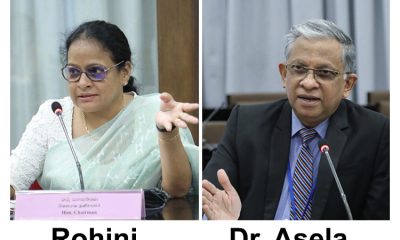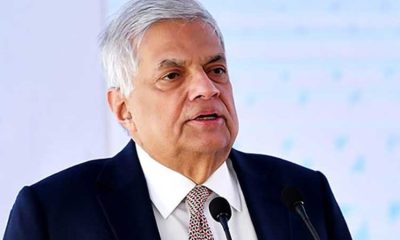Features
Ranil is running out of time and tricks, now it’s time the people had their say

by Rajan Philips
The first part of the title needs no elaboration. The second part is an unfolding question that has many answers to it, and which one of them will eventually prevail also depends on multiple factors. Objective circumstances, agency roles and subjective leadership moves are all at play. The simplest way to exit in politics is to resign. No amendment, no majority, or no referendum is needed.
The last President, Gotabaya Rajapaksa, unwittingly established a new precedent in Sri Lankan politics when he resigned from office after running away from it. All that said, Sri Lankans could also be thankful to Mr. Rajapaksa for leaving the way he did, unlike say Benjamin Netanyahu in Israel whose belligerence has created the most explosive situation for the region and the world in the 21st century.
No one is expecting President Wickremesinghe to resign before his carryover term from his predecessor is over. But there are plenty of speculations and suspicions about Mr. Wickremesinghe’s political intentions and the tricks that he might play to extend his stay in power. When it comes to elections, no matter what elections, no one has a clue about what the President is going to do. The truth is even the President may not be knowing what he is going to do, because he is constantly looking for winning conditions for him to call an election.
The tricks he plays!
For Ranil Wickremesinghe, winning conditions are hard to come by. Absolute power has come to him late in life, but there is no assurance of winning an election in spite of his powers and even after such a long time in politics. The alternative to not winning an election is not to have an election. Or keep changing election timing to improve winning chances. President Wickremesinghe has been trying everything. And he has everyone else chasing whatever election rabbit he pulls out of his scheming cap.
He cancelled the local government elections without saying anything about it, while letting everyone else agitate over it. He floated the idea about provincial council elections to keep everyone guessing. He got his sidekicks to spread rumours about advancing the presidential election even though as an interim president he is not entitled to do so.
Then came suggestions that he might try to advance the timing through a constitutional amendment. That was a dead end move because there was never going to be two-thirds majority support for it in parliament, where the opposition parties have been clamouring for parliamentary elections to be held after local government elections.
The one power that the President now has is to dissolve parliament and have new parliamentary elections. Mr. Wickremesinghe will not do that because he cannot put together a winning coalition, and the MPs who are supporting him in parliament now are scared to face an election. So, he opens a new window for distraction – electoral reforms, which have now taken a life of their own with the gazetted appointment of a Presidential Commission that is tasked to complete its work before April, unwittingly, but also fittingly for April Fools day, 2024!
In between came suggestions for abolishing the presidency, because the President is said to have figured out that he is not likely to get more than 50% votes on the first count, and he is not going to be high in the second or third preferences of those who are not going to vote for him in the first place. Put another way, Ranil Wickremesinghe is not the first, second or third best presidential candidate to a majority of Sri Lankan voters. That seems to be the assessment of all the president’s men. Hence the move to abolish it, as the last resort.
Mr. Wickremesinghe has played the abolition card before – in the dying days of the yahapalana government, when he suggested abolition after the UNP decided on Sajith Premadasa as its presidential candidate for the November 2019 presidential election. It became a laughing proposition then. Even Mangala Samaraweera laughed out loud.
This time, Anura Kumara Dissanayake has made a brilliant counter proposition that a constitutional amendment to abolish the ‘executive presidency’ should be coupled with the dissolution of parliament leading to a new general election.
The election itself could be coupled with a referendum on abolishing the executive presidency. To be clear, abolishing the executive presidency means only removing the elected presidency and reducing its powers to those appropriate for a head of state in a parliamentary democracy. To be clear as well, such a reform of the presidency should not require a referendum, as argued expertly by Dr. Nihal Jayawickrama in the Sunday Island last week.
Even so, there will be no harm in piggybacking a referendum question on presidential reform during a parliamentary election. A clear referendum result will put an end to a very longstanding question. In any event, the abolition kite never took off, let alone flew.
Finally, the nation, or nations, heard from the horse’s mouth that there will be elections, that is the presidential and parliamentary elections as and when they are due. Addressing the Special General Convention of the United National Party at the Sugathadasa Indoor Stadium in Colombo, last Saturday (October 21), President Wickremesinghe reportedly “outlined the timeline for upcoming elections in line with the constitutional provisions” – presidential election in 2024, followed by parliamentary elections, and local government elections in the first half of 2025. One would think that the President was not merely repeating the constitutional timeline for presidential and parliamentary elections which most people know, and that he was implicitly confirming that the two elections will be held as they come due.
Many are understandably skeptical and unsure if the President is being sincere or whether he is pulling another fast one. Like how he shooed away the local government elections. The sudden appointment of a new, nine-member commission on election reforms headed by former Chief Justice Priyasath Dep, certainly reinforces people’s skepticism about the President’s sincerity.
The specific tasking of the commission to make study the potential for enabling concurrent representation in both the parliament and the provincial councils is yet another example of Mr. Wickremesinghe’s presidential panache for making seemingly innovative, but which are in fact nonsensical suggestions. This might be the reason why there seems to have been no mention of provincial council elections at the UNP convention. There may not be any mention of them at all until we find out if the President is serious about enabling elected representatives to be concurrent members of both the parliament and the provincial councils.
Smart Dekma
Let us look at it another way. The theme of the UNP convention was “Smart Country – 2048.” One would have thought that country has seen the last of such cliches after the sensational collapse of Gota’s “Saubhagyaye Dekma” nonsense. Now we have the new Ranil version – Smart Country 2048, in pure English. Thankfully, it is not being splashed across the country as the Gota prototype was.
That is also because the UNP now is mostly a one-man state show. It does not have the prop up of 6.9 million who voted for Gotabaya Rajapaksa or 5.5 million who voted for Sajith Premadasa. Put another way, Smart Country has little chance of blossoming into a winning national platform.
My point here is something else. 2048 is the President’s target year for Sri Lanka reaching economic self-reliance and take off. With all the focus on the digital, the take off could turn out to be a virtual one. To make this a real one many concrete steps and short flights will have to be taken for the next 25 years starting from now. But we haven’t heard anything by way of a concrete plan or program from the President. Nor has the President demonstrated that he is assembling a political team that is worthy of the grand economic project that he claims he is launching.
There is nothing transparent about the team the President might be having outside parliament. And everything is transparent about the team of MPs that he has in parliament – their corruption, incompetence and their becoming increasing unelectable. The President has not articulated anything about whether the current political system and the institutional machinery are adequate for the grand purpose of delivering economic liberation by 2048.
Nor has there been any hint of what might come after him, for after all he is not expecting to be around till the day of deliverance in 2048. All that the country has had from him, politically speaking, is one trick after another to scupper one election or another. The last of them is the President’s recitation of the election timeline at the UNP convention.
So, it is understandable that there are criticisms and concerns that the President is pulling another fast one on the people. And the political counter to the President’s manoeuvres and machinations has already started. The time for fast ones is over, and there should not be any more postponement of elections. The President’s manoeuvres are likely to be countered both within parliament and outside parliament.
The opposition parties could request the Election Commission to make early announcement of election timelines – voter registration, nominations, and polling date, to keep the pressure on the President not to cancel or postpone the presidential election or the parliamentary election. The forthcoming budget process and debate could be used to ensure that sufficient funds are allocated for the two elections, and to get repeated commitments from the President that there will be no budgetary excuses to cancel or postpone either the two national elections.
Next to resigning or retiring, the most straightforward exit from power is electoral defeat. Ultimately the people will decide if President Wickremesinghe deserves to stay in office beyond the five year term for which Gotabaya Rajapaksa was elected in November 2019. Mr. Wickremesinghe’s best argument for the people’s vote is that he has managed to restore economic stability from the chaos that was handed to him. But the stability that he is now presiding over is tenuous at best and will not be sustainable when the country starts repaying its debts.
He may have deserved an extended stay in power to look after the economy if he had just done that – look after the economy without playing tricks with elections. Instead, President Wickremesinghe has been using and abusing the power of his office either to avoid facing the electoral test or to bolster his electoral prospects. Now it is time the people got their turn to exercise the power of their vote to say who shall be the next President or who will form the next government.
Features
All in the mind!

The Buddha, born as Prince Siddhartha, attained Enlightenment and Parinibbana all on a Vesak full-moon day, would have never anticipated that millions of followers of his doctrine would be celebrating this day, all over the world with festivities, over 2500 years later. Perhaps, what is happening in his name is not what he expected, indulging in festivities than following the path he showed for ultimate detachment. Perhaps, as an inevitable consequence of Buddha Dhamma’s transformation, by his followers, to a religion was the emergence of Buddhist art, culture, literature etc. Though this has, no doubt, enriched the lives of many, including non-Buddhists, with the displays of creativity at the highest level in these festivities, we should not forget the core message of the Buddha.
In the search for the reasons for the ever-pervading sense of dissatisfaction and the way to overcome it, the Buddha became the unsurpassed analyst of the human mind and thoughts, his concepts being validate by science, two and a half millennia later! Though Hans Berger, the inventor of the Electro Encephalogram (EEG), which records the electrical activity of the brain, is credited with the proposition that the brain is always busy, the Buddha not only stated that the mind is constantly bombarding us but also showed us how to control the mind. He also showed that the world around us was a creation of our mind and had included the mind also as a sense, on top of the five senses acknowledged by scientists. His concept that the mind is the sixth, the modifier sense is validated now, as it is shown that what see is what we want to see and what we hear is what we want to hear etc.
One of the biggest problems we have is endless thinking. As we wake up in the morning, we think of what happened yesterday or about the dreams we had the previous night. One can even go to the extent of saying that our thoughts are bombarding us even in sleep in the form of dreams. Though some of these thoughts are productive, in the main we torture ourselves thinking how we could have done better, even though it is an exercise in futility as what happened in the past cannot be undone. Our mind gets attached to some events in the past and have endless thoughts about these events which is of no use other than leading to a sense of depression. We then think of what we have to do tomorrow and anxiety creeps in. In this process we forget what is most important; the present! Scientists explain all this based on the Default mode network (DMN) in our brains, a set of connected parts of the brain which acts as a network which is responsible for remembering the past and imagining the future as well as thinking of others. Some scientists opine that it is the neurological basis for the ‘self.’
The Buddha pointed out that whatever misdeed happened in the past is like the pain one gets when hit with an arrow fired by someone else and that thinking again and again about it is like taking a second arrow and stabbing yourself with it. Though the pain inflicted by the first arow is natural, the second is our own making which prolongs the agony by torturing ourselves. What is needed is the avoidance of overthinking and being aware of the thoughts. Emptying the mind of the bombarding unnecessary thoughts increases awareness. Instead of being the driver of the car, we should attempt to be the passenger who is at liberty to enjoy the view and this could be achieved by mindfulness, a concept introduced by the Buddha. There is ever increasing scientific evidence, using dynamic MRI studies and PET scan studies, that mindfulness meditation reduces the activity of the DMN in our brains.
Mindfulness meditation is a way of slowing down thinking, concentrating on the present whilst getting rid of unnecessary baggage of thoughts of the past and the future. Emptying the mind of thoughts that act as a noise imparts a sense of clarity. It is not an easy task as we are attempting to go against what the brain is programmed to do via the DMN which functions to preserve the self. Unfortunately, mindfulness has become big business and the Buddha is not even credited for introducing the concept!
Thinking is an essential process in human development as well as human destruction, as exemplified by many wars raging around us at this moment. Right thinking is one of essentials in the Noble Eightfold Path, the Buddha laid for us for the purpose of achieving ultimate detachment. In addition to thinking correctly, we should get rid of harmful thoughts which leads to renouncing attachment, kindness and letting go of harmful intentions. On the basis of this a new modality of treatment has emerged for mental illnesses; cognitive behaviour therapy (CBT) which teaches patients that some thoughts are false and also to recognise which thoughts are useful and which are harmful, one of the most effective being mindfulness-based CBT.
It is important to know when to think and when not to and as the Buddha stated, “Think when it is useful but do not be a slave to thoughts, which is the basis of wisdom.”
Buddha also showed that by progressively suppressing thoughts one could reach a stage where awareness exists without thoughts and could go further where there is no awareness either, resulting in ultimate detachment. Once you reach this stage, thoughts are used only as and when necessary, without any attachment at all. Thus, the Buddha showed that all is in the mind including the way to control.
The inspiration to pen these Vesak thoughts came by watching an excellent video forwarded by Ven Teldeniyaye Amitha Thera of Nottingham Shanti Vihara, in the course of fortnightly Vipassana meditation sessions conducted via Zoom. My respectful thanks go to Ven Amitha Thera and I highly recommend “What Happens When You Stop Thinking? Buddhism’s answer” which is available on YouTube. The link is: (https://www.youtube.com/watch?v=tfTiA2_FtEw)
Happy Vesak!
By Dr Upul Wijayawardhana
Features
Dhammam Saranam

After a Dhamma session I attended, a participant inquired about the meaning of taking refuge in the Three Jewels (Triratna). A longtime meditation practitioner volunteered that it is a powerful mantra that helps to awaken the mind and go to the higher self. I have no idea what he meant by that, but a flood of emotions rushed my mind. Empathy for the believer, for one; but it occurred to me that I have not given much thought about it either, at least for quite a while.
The fact of the matter is that taking refuge in the ‘Three Jewels’ is our tradition. A tradition is just that, the transmission of customs or beliefs from generation to generation, with no questions asked. The term refuge is defined as a condition of being safe or sheltered from pursuit, danger, or trouble. What is the danger we are seeking shelter from? As a child, I had my own explanations: according to Buddhacharithaya we were taught, Buddha was omniscience and omnipotent, and there was no doubt that such powers could protect you from any danger.
A similar mystic power was attributed to Dhamma as well; leaving the radio on in full volume when the protective suttas were broadcast was assured to bring safety and health. Sangha, on the other hand, were there to bless us in good and tough times: moving into a new house, starting a new job, recuperating from an illness, or even after death to secure a better afterlife by transferring merits.
Such musing aside, I wonder if this tradition has been satisfactorily explained to us, not just as children but as adults as well. Especially, how Dhamma could be a refuge or what is expected when we recite Dhammam Saranam ever so often? It occurred to me that there is a gap in our education. An investigation of the literature reveals that I am not alone, scholars too have identified this shortcoming: our Buddhist education has failed.
I received good grades in Dhamma studies, and I memorised the entire book we used for our ordinary level exam; even then, how is my knowledge of Dhamma incomplete? As not many undertake Dhamma studies after leaving school, how and when such a gap in education could be filled? Well, it has been a problem with historical origins, and the collapse of socio-religious institutions of the country bear witness to this fact, the scholars reason. If we agree with the scholars’ notion that our Dhamma education is inadequate, it behooves us to explore what part of it was left out of our education.
Right after the Parinibbana, the Sangha recognised the need for preserving Dhamma, and they produced the system of memorisation and interpretation of it for the benefit of the followers. This is the system that Arahant Mahinda brought to Sri Lanka. When many members of the Sangha were decimated during Great Famine in the first century BCE, the question arose whether learning and preservation of Dhamma was more important than practice.
The advocates of learning and preservation prevailed. By the beginning of seventeenth century, the practice had completely disappeared, and Buddhism was reduced to a set of rituals acquired from other traditions in the hands of Ganinnanses. When venerable Welivita Saranankara thero (1698-1778) started the Buddhist revival, he had to learn Pali and reinterpret the Dhamma.
This process of reinterpretation continues to date. Venerable Sangha tries to do this for the benefit of laity, in person and using all other available media. Scholars analyse it and write volumes for the sake of knowledge, and devotees follow various meditation recipes hoping it will dawn on them and lead to spiritual salvation. Whatever path followed, there are several pitfalls that must be avoided for a successful outcome.
These are the drawbacks that our Buddhist education has failed to avoid: First, the goal of education must be identified, and Dhamma relevant for the goals of the followers must be taught. Second, the origin and purpose of Pali and Sinhala commentaries must be understood, and their relevance must be verified. Third, the bondage to tradition must be relaxed, otherwise, we get trapped in a vicious cycle. Lastly, Dhamma must be taught in terms that are accessible to modern society.
Returning to the main question, let us focus on Dhamma first: the Pali word Dhamma has many meanings, but here it refers to what the Buddha taught, which is represented by Tipitaka, the Theravadin’s Pali Canon. Then the question arises whether it is necessary to absorb the entire contents of the twelve-thousand-page Canon to grasp the meaning of Dhamma? Scholars are of the opinion that it is not necessary; they point out that the essence of Dhamma is captured in the first two sermons of the Buddha given at the Deer Park in Isipatana to the five ascetics.
Yes, everything one needs to know about Dhamma is captured in these two suttas (Nanamoli 1995). The remaining ten thousand plus Suttas are on various explanations of his teaching by Buddha to suit different audiences and occasions. They do not deviate from the contents of the first two, and that consistency is further proof of this summation. Some scholars go even further, they say that the simple verse uttered by Assaji in response to Upatissa’s question encapsulates the essence of the Dhamma:
Of those things that arise from a cause,
The Tathagata has told the cause,
And also, what their cessation is:
This is the doctrine of the Great Recluse.
Everything in twelve thousand pages of text condensed into a single verse! In modern parlance, this verse means “When A is, B is; A arising, B arises; When A is not, B is not; A ceasing, B ceases.” It can be further simplified to ‘Everything comes to existence because of causes and conditions. If we had to stop something from coming into existence, its causes and conditions must be eliminated.’ According to science, this is the law of cause and effect that applies to all phenomena in this universe. Upatissa was said to have become sotapanna, the first stage to liberation upon hearing this verse. Dhamma is also referred to as Hethu Pala Dahama for this reason.
In fact, this simple verse, known as the Paticcasamuppada Gatha, can be considered as the first principle from which the Dhamma in its entirety can be derived. If it governs everything, it must apply to the cycle of samsara as well, ending of which is the supreme goal. Upatissa was said to have sufficient training to unravel the complex message contained in this simple verse and see the Dhamma. Can we get a glimpse of this rationalising process?
If something comes to existence due to causes and effects, it must have a beginning, a progression, and an end. In science, it is called a process, an activity, but not a static object. Just like running, eating, or growing. It does not make sense, you may say; how can this paper on which this essay is printed, held in my hands, which I can feel, smell, and taste if I wish, not be a thing? That is the conventional way of thinking. The other way to look at it is to see its history.
The newsprint was produced from pulp that came from a pine, spruce, or a fir tree growing in the northern hemisphere. The trees grew from seeds, which came from pollen and so on. Every transformation involved in that process required some conditions: chemicals, heat, and water to make paper, and soil, rain, and cold climate for the pine trees to grow. Contemplating the causes and conditions of any phenomenon is not only a fun exercise for a science student, but also a way to meditate on impermanence by anyone interested. However, the way we relate to time gets in the way.
We humans have evolved accustomed to the day-night cycle. Compared to that twenty-four-hour cycle, some processes appear fast while some others appear unimaginably slow. As Einstein pointed out, time is a relative concept. A rock may appear to be a thing, but it is also a process: it is hardened magma that will eventually erode, wash into the ocean, move with tectonic plates, and end up as magma once more. In human time scale, that process is unfathomable, but in cosmic time scale it is a mere split second.
If the earth were twenty-four hours old, humans would have existed only for three seconds, for example. On the other extreme, some insects live only a few hours. For them, in their timescale, humans may appear to be eternal. It may be hard to wrap our heads around, but if we can leave time factor aside, everything becomes a process, which means they are in a state of constant change. This is even more so at atomic level. The scientific term for this state of continuous change is flux. That is what Dhamma teaches us, but were we told that in the class? Yes, in Pali it is called Anicca. Any phenomenon that arises this way is referred to as Sankhara, meaning put together or compounded (Dhammapada verse 277).
All natural phenomena like birth, aging, sickness, and death are such processes. While they are inevitable aspects of life, Dhamma pays more attention to mental processes, which also have the same properties. They too are in flux and devoid of substance. Another characteristic of processes is that as they depend on conditions and causes, they are not under the control of an agent, neither human nor superhuman. Justifiably, free will or conation becomes debatable under such conditions.
That means processes lack substance, purpose, or agency; they keep running based on the causes and conditions. There is no doer. This is defined as no self, which Pali describes as Anatta. According to Dhamma, the notion of a permanent self is merely a convention. However, there is a crucial distinction about mental processes; the human mind can be developed to have some control over mental processes, a key element of Dhamma.
by Geewananda Gunawardana, Ph.D.
(To be concluded)
Features
Championing Geckos, Conservation, and Cross-Disciplinary Research in Sri Lanka

In the vibrant tapestry of Sri Lanka’s biodiversity, where rainforests pulse with life and endemic creatures lurk under every leaf, Dr. Nimal D. Rathnayake has carved a unique niche — one that combines the precision of a scientist with the strategic insight of a marketer.
A leading voice in herpetology and a respected academic in the fields of tourism and management, Dr. Rathnayake is a multidisciplinary force, passionately working to conserve reptiles — especially the often-overlooked geckos — while also reimagining how humans interact with nature.
A Childhood Rooted in Discovery
Dr. Rathnayake’s journey into the world of reptiles began in his youth. Growing up with an innate curiosity about the natural world, he joined the Youth Exploration Society of Sri Lanka (YES), a group dedicated to inspiring young people to explore and understand the environment. His early exposure to fieldwork through YES and later, the Amphibia and Reptile Research Organization of Sri Lanka (ARROS), laid the foundation for a lifelong engagement with herpetology.
ARROS, a grassroots organisation with a strong emphasis on field-based research and conservation, gave Dr. Rathnayake the platform to pursue his fascination with amphibians and reptiles more seriously. It was here that he honed his skills in species identification, ecological monitoring, and data collection — skills that would become essential to his later academic pursuits.
The Silent Stars: Geckos of Sri Lanka
While Sri Lanka is renowned for its charismatic wildlife — elephants, leopards, and blue whales — Dr. Rathnayake has dedicated much of his scientific career to one of the island’s most understated yet ecologically important creatures: geckos.
Sri Lanka is home to more than 50 species of geckos, many of them endemic and highly localised. These small, nocturnal reptiles play crucial roles in the ecosystem as insect predators and as prey for larger animals. Despite their importance, geckos are often ignored in mainstream conservation efforts.
Dr. Rathnayake’s research on geckos has helped shift that narrative. Through detailed ecological studies, he has contributed to understanding their behaviour, habitat preferences, and conservation status. His fieldwork has included both rainforest-dwelling species such as the Cnemaspis geckos — which cling to the moist boulders of the wet zone — and dry-zone species like the agile Hemidactylus that thrive in arid, rocky landscapes.
Much of his work has highlighted the vulnerability of geckos to habitat fragmentation and deforestation. Many species have extremely limited ranges, making them especially sensitive to environmental change. Dr. Rathnayake advocates for the inclusion of microhabitats — such as rocky outcrops and forest understory — in conservation plans, which are often overlooked in broader biodiversity strategies.
A Scholar of many languages: Science, Marketing, and Management
Dr. Rathnayake’s academic career is as diverse as the ecosystems he studies. With over 25 published papers and several books, he has explored topics that span from ecological fieldwork to the intricacies of tourism marketing and destination management. His dual expertise in science and business places him in a unique position to craft interdisciplinary solutions to environmental problems.
One of his key areas of focus is ecotourism — a sector with tremendous potential in biodiversity-rich Sri Lanka. Drawing from his research in marketing and management, Dr. Rathnayake emphasises the importance of balancing tourism growth with environmental responsibility. He is a vocal advocate for wildlife-based tourism models that prioritise education, ethical practices, and community involvement.
His work often draws on field data from herpetological studies — such as gecko population dynamics or habitat assessments — to inform tourism planning. For instance, understanding the specific conditions required by a rare Cnemaspis species can help guide decisions about where to place hiking trails or visitor lodges, minimising disruption to fragile habitats.
Building Bridges Between Academia and Conservation
One of Dr. Rathnayake’s most valuable contributions lies in his ability to bridge academic research with practical, on-the-ground impact. His collaborations with local communities, conservation NGOs, and tourism authorities have helped translate science into policy and practice.
He has also been a dedicated mentor to young scientists, guiding students and early-career researchers through fieldwork, data analysis, and publication. His roots in YES and ARROS continue to inform this commitment to youth engagement. For Dr. Rathnayake, fostering a love for science in young people is not just a passion — it’s a strategy for ensuring long-term conservation.
His outreach also extends beyond academia. He frequently speaks at public forums, contributes to media features, and participates in educational programmes aimed at demystifying reptiles. In a culture where snakes and lizards are often feared or misunderstood, his efforts to raise awareness are a crucial part of building public support for conservation.
Sri Lanka’s biodiversity faces increasing pressure from urbanisation, agriculture, climate change, and illegal wildlife trade. Dr. Rathnayake warns that without strategic, science-informed planning, many of the country’s lesser-known species — including endemic geckos — could disappear before the public even knows they exist.
He emphasises that conservation can no longer exist in isolation. “We must think across disciplines — biology, economics, policy, education — if we are to create sustainable models for both nature and people,” he often says.
His vision includes scaling up community-based ecotourism, promoting habitat restoration projects that include gecko microhabitats, and advocating for stronger legal protections for reptiles. Through his research and advocacy, Dr. Rathnayake is working to ensure that conservation in Sri Lanka evolves with the times — grounded in rigorous science, yet responsive to social and economic realities.
In the world of conservation science, specialisation is often the norm. Yet, Dr. Rathnayake has forged a different path — one that values integration over isolation, and collaboration over competition. From the quiet movements of a forest gecko to the complex dynamics of an eco-tourism, he navigates it all with depth and clarity.
As he continues his work, Dr. Rathnayake remains a strong voice in both national and international discussions on biodiversity. His story is a reminder that impactful science isn’t confined to labs or lecture halls. Sometimes, it begins with a child watching a lizard on a tree trunk — and grows into a lifetime of discovery, mentorship, and conservation.
By Ifham Nizam
-

 Business6 days ago
Business6 days agoAitken Spence Travels continues its leadership as the only Travelife-Certified DMC in Sri Lanka
-

 Latest News5 days ago
Latest News5 days agoNPP win Maharagama Urban Council
-
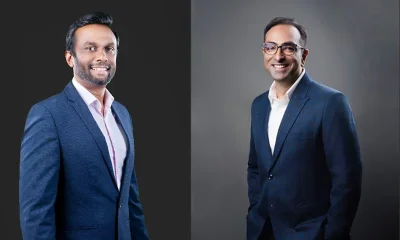
 Business6 days ago
Business6 days agoLinearSix and InsureMO® expand partnership
-

 Business4 days ago
Business4 days agoJohn Keells Properties and MullenLowe unveil “Minutes Away”
-

 Features1 day ago
Features1 day agoSAITM Graduates Overcome Adversity, Excel Despite Challenges
-

 Sports1 day ago
Sports1 day agoASBC Asian U22 and Youth Boxing Championships from Monday
-

 News1 day ago
News1 day agoDestined to be pope:Brother says Leo XIV always wanted to be a priest
-

 Foreign News2 days ago
Foreign News2 days agoMexico sues Google over ‘Gulf of America’ name change



